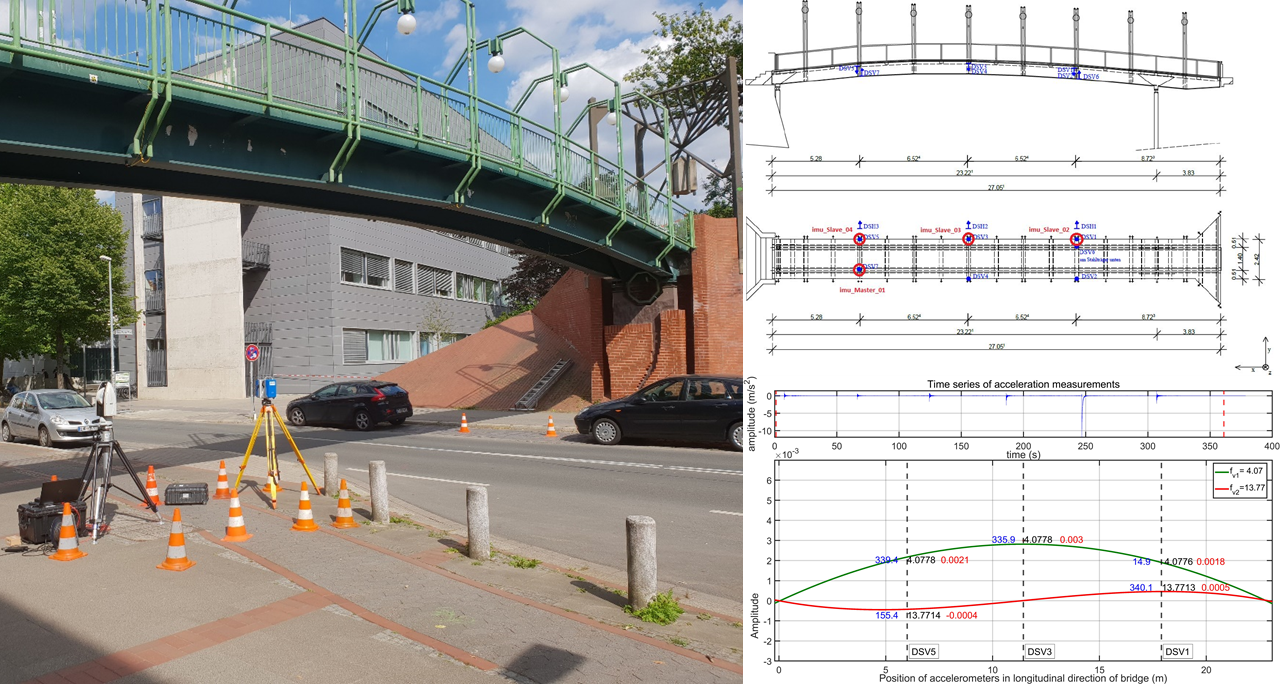
Robust vibration analysis of bridge structures using low-cost accelerometers
Permanent, reliable, and cost-effective deformation monitoring of bridge structures are still challenging issues. Approximately, 21% of all bridges in Germany have been constructed before 1980, which highlights the demand for a massive interdisciplinary monitoring by cooperation between geodesists, civil engineers and geotechnical engineers.
In this study, a geosensor network of low-cost micro-electro-mechanical-systems (MEMS) accelerometers of type BNO055 from Bosch GmbH are mounted at certain positions of the bridge structures, which are precalculated by means of a finite element model (FEM) analysis. Despite of purchase price and sampling frequency, a three-step scenario is proposed to select a suitable MEMS accelerometer, which include robust calibration procedure, controlled excitation as well as static test experiments. The calibration procedure is performed for fixed positions using a KUKA youBot in a climate chamber over certain temperature ranges, which enables to model and degrade MEMS related systematic errors such as biases, scale factors, and non-orthogonality angles between the axes.
Typically, the acceleration data recorded from low-cost MEMS accelerometers are contaminated with a high colored measurement noise, which influences the accuracy of the estimated modal parameters including eigenfrequencies, eigenforms and modal damping. For this purpose, Omidalizarandi et al. (2020) proposed and implemented a robust and automatic vibration analysis procedure the so–called robust time domain modal parameter identification (RT-MPI) approach. By applying the aforementioned algorithm, an excitation (e.g. ambient) window is selected automatically. Next, initial eigenfrequencies even closely spaced ones are identified based on the cost function in an optimization procedure. The frequencies, damping ratio coefficients, amplitudes, and phase shifts are estimated by defining an observation model consisting of a damped harmonic oscillation model, an autoregressive model of colored measurement noise and a stochastic model in the form of the scaled t-distributions with unknown degree of freedom and scale factor. The aforementioned three parametric models are jointly adjusted by means of a generalized expectation maximization (GEM) algorithm given in Alkhatib et al. (2017). The eigenforms are characterised in a subsequent step using the estimated parameters from the GEM algorithm.
Experiments are performed for two real applications of a footbridge structure and a synthetic bridge. The estimated modal parameters are compared with a well-known covariance driven stochastic subspace identification (SSI-COV) approach. In addition, they are validated with their corresponding estimates obtained from reference sensors. The results demonstrate that the MEMS accelerometers are suitable for identifying all occurring eigenfrequencies of the bridge structures. At the end, the analyses reveal the superiority of the proposed RT-MPI algorithm compared to the SSI-COV algorithm.
